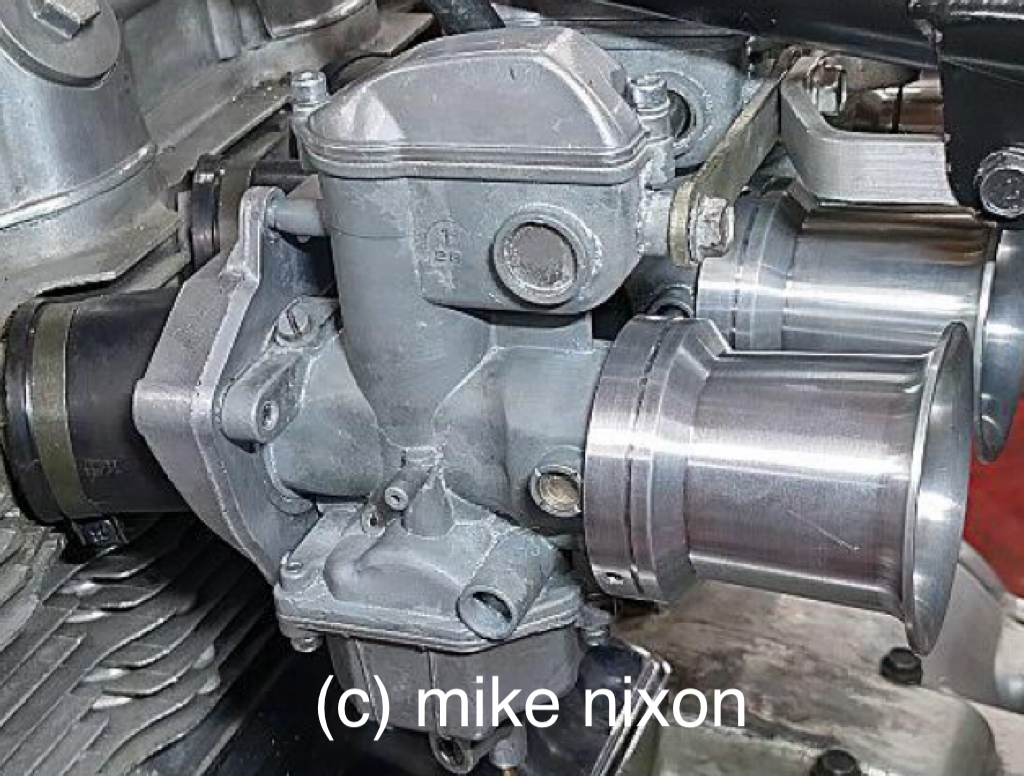  ® ®
|
The pilloried PD (carburetor) |

I am a champion of the PD series Keihin carb as fitted as original equipment on some of Honda's SOHC four models: the late CB550, the early CB650, the 750 Automatic and the late CB750. I do not agree with those on forums who say this carburetor is troublesome. I think it is a much better carburetor than folks assume. Easy to work on (the easiest of all the SOHC four carbs), uncomplicated, and a good performing carb. I have a carburetor rebuild how-to book specifically on the PD carb that covers all of these models.
Since the PD carb is found on several 70s Honda models, this brings a host of potential issues into the mix when considering engine running symptoms. While the carburetor may indeed (and I think inevitably) require attention, it is false to assume the carburetor should necessarily be the focus of performance issues. Ignition service, especially up through 1978 models, is virtually assured to be much more in need of proper maintenance than will the carburetor, solely on the basis of correct Kettering ignition service unfortunately being a lost art. And not only a lost art but a forgotten and unaccepted ethos entirely. Owners of these bikes just can't be convinced that the ignition system is as crucial to good engine running as it is. I have tried for decades. Nobody will believe it. Nor do people understand how cylinder compression affects carburetion. Low compression leans your carbs. And all of these old Hondas suffer low compression. Take care of the other stuff before focusing on the carburetors.
A few more things to consider. The idle jet really must be removed for cleaning when rebuilding these carburetors. It is necessary to get the idle passage under the jet clean, and the jet itself can't adequately be cleared without it in hand. You must clear the air bleeds also. If you're not sure what those are, get help. The float bowl venting has to be vetted also. The PD carb has two different kinds of bowl venting. The 77 750 models have a more crude system, the 78 750 is more sophisticated. Both have to be attended to. The pilot screw o-ring must be replaced and the original one dug out of the carb body or the engine idle will not be consistent. And set the pilot screw to 3 turns out. All PD carbs on all stock bikes need this. The 77 750 carb has an adjustable jet needle and the 78 750 not, though the 78 is easily adjusted in a non-conventional way. However, needle adjustment is very rarely a good idea--basically only when engine modifications are in view. This carburetor is not, as many insist, wrongly jetted at the factory. Folks who say this have bikes with either modifications or with neglected maintenance, with the latter being a given. Get the circuits clean, use the factory specifications--except for the pilot screws--and sync them carefully and these carbs will work very well for you. But this assumes you have good intake sealing, over 150 psi cylinder compression, fuel that is less than a month old, the stock intake system (air filter element, box, ducting, cover, etc.), stock exhaust, good ignition coils, good plug caps, clean genuine NGK plugs, and the timing set properly (both statically and dynamically) using factory points. On properly modified and set up 750s, these carbs really shine. The older carbs don't come close.
Many seem to angst about the float level. To begin with, set the float level with the carburetor right-side-up. Use the factory spec--the 77 and 78 750 carbs have different specs--and don't view the float hanger's angle as anything important. The forums' insistence that the hanger must be perfectly horizontal is wrong. It has no bearing on correct adjustment. Many carbs' floats when properly adjusted do not have their hangers precisely horizontal. Some models do, but many more do not.
More don'ts. Take these to heart, they're important.
The PD carbs are much better than forums posters believe. They excel over the 69 through 76 CB750 carbs in a number of ways. The single throttle shaft is just the beginning and similar to Mikuni tech. But these carbs are also slightly larger in diameter, a definite advantage on modified engines. Then there is the accelerator pump, the superior float bowl drain system, the more reliable float bowl gaskets, the built-in (and adjustable) fast idle system, and much easier access to the jet needle. In fact, many riders back in the day used these as performance enhancers for their older 750s, and continue to today. They're great carburetors.
|
|
Last updated July 2025 Email me www.motorcycleproject.com My bio © 1996-2025 Mike Nixon |